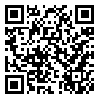1. 1. American Psychiatric Association. Diagnostic and statistical manual of mental disorders. 5th edition. Arlington, VA: American Psychiatric Association; 2013, pp:133-7.
2. 2. Ruscio AM, Hallion LS, Lim CCW, et al. Cross-sectional comparison of the epidemiology of DSM-5 generalized anxiety disorder across the globe. JAMA Psychiatry. 2017;74(5):465–75. [
DOI]
3. 3. Omani-Samani R, Ghaheri A, Navid B, Sepidarkish M, Maroufizade S. Prevalence of generalized anxiety disorder and its related factors among infertile patients in Iran: a cross-sectional study. Health and Quality of Life Outcomes. 2018;16(1):129. [
DOI]
4. 4. Mansouri A, Farnam A, Bakhshipour Roodsari A, Mahmood Aliloo M. The comparison of rumination in patients with major depression disorder, obsessive-compulsive disorder, generalized anxiety disorder and normal individuals. Journal of Sabzevar University of Medical Sciences. 2010;17(3):189–95. [Persian]
5. 5. Brinker M, Brosché M, Vinocur B, Abo-Ogiala A, Fayyaz P, Janz D, et al. Linking the salt transcriptome with physiological responses of a salt-resistant populus species as a strategy to identify genes important for stress acclimation. Plant Physiol. 2010;154(4):1697–709. [
DOI]
6. 6. Nolen-Hoeksema S, Davis CG. “Thanks for sharing that”: ruminators and their social support networks. Journal of Personality and Social Psychology. 1999;77(4):801–14. [
DOI]
7. 7. Rachman S. Emotional processing, with special reference to post-traumatic stress disorder. International Review of Psychiatry. 2001;13(3):164–71. [
DOI]
8. 8. Baker R, Thomas S, Thomas PW, Owens M. Development of an emotional processing scale. Journal of Psychosomatic Research. 2007;62(2):167–78. [
DOI]
9. 9. Borkovec TD, Alcaine OM, Behar E. Avoidance theory of worry and generalized anxiety disorder. In: Heimberg RG, Turk CL, Mennin DS; editors. Generalized anxiety disorder: advances in research and practice. New York: Guilford Press; 2004.
10. 10. Orsillo SM, Roemer L, Block-Lerner J, LeJeune C, Herbert JD. ACT with anxiety disorders. In: Hayes SC, Strosahl KD; editors. A practical guide to acceptance and commitment therapy. Boston, MA: Springer US; 2004. pp: 103–32. [
DOI]
11. 11. Lewis M, Naugle A. Measuring experiential avoidance: evidence toward multidimensional predictors of trauma sequelae. Behavioral Sciences. 2017;7(4):9. [
DOI]
12. 12. Hayes SC, Strosahl KD, Wilson KG. Acceptance and commitment therapy: the process and practice of mindful change. Second ediotion. Guilford Press; 2011.
13. 13. Demehri F, Saeedmanesh M, Jala N. The effectiveness of acceptance and commitment therapy (ACT) on rumination and well-being in adolescents with general anxiety disorder. Middle Eastern Journal of Disability Studies. 2018;8:25. [Persian] [
Article]
14. 14. Ainsworth B, Bolderston H, Garner M. Testing the differential effects of acceptance and attention-based psychological interventions on intrusive thoughts and worry. Behaviour Research and Therapy. 2017;91:72–7. [
DOI]
15. 15. Ruiz FJ, Hernández DR, Suárez Falcón JC, Luciano Soriano MC. Effect of a one-session ACT protocol in disrupting repetitive negative thinking: a randomized multiple-baseline design. International Journal of Psychology and Psychological Therapy. 2016;16(3):213–33. [
Article]
16. 16. Tarkhan M. The effectiveness of acceptance and commitment therapy (ACT) on emotion regulation and life meaning of depressed women. Journal of Psychological Studies. 2017;13(3):64–147. [Persian]
17. 17. Asghari M, Faleh Kar A, Zaree A, Mirza Hoseini F, Amani O. Comparison of the efficacy of acceptance commitment therapy and electrical stimulation with alternating current on mood symptoms in depressed patients. Iranian Journal of Nursing Research. 2018;13(4):16–23. [Persian] [
Article]
18. 18. Spitzer RL, Kroenke K, Williams JBW, Löwe B. A brief measure for assessing generalized anxiety disorder: the GAD-7. Arch Intern Med. 2006;166(10):1092–7. [
Article]
19. 19. Nolen-Hoeksema S, Morrow J. A prospective study of depression and posttraumatic stress symptoms after a natural disaster: The 1989 Loma Prieta earthquake. J Pers Soc Psychol. 1991;61:115-21. [
DOI]
20. 20. Naeinian MR, Shairi MR, Sharifi M, Hadian M. To study reliability and validity for a brief measure for assessing generalized anxiety disorder (GAD-7). Clinical Psychology & Personality. 2011;3(4):41–50. [Persian] [
Article]
21. 21. Lotfi S, Abolghasemi A, Narimani M. A comparison of emotional processing and fear of positive/negative evaluations in women with social phobia and normal women. Journal of Knowledge and Research in Applied Psychology. 2013;14(3):101–11. [Persian]

 ، عاطفه ظهیری مژدهی2
، عاطفه ظهیری مژدهی2 
 ، منیر زمانی3
، منیر زمانی3 
 ، فائزه ذبیحی اسکویی*
، فائزه ذبیحی اسکویی* 
 4، امید امانی5
4، امید امانی5 




